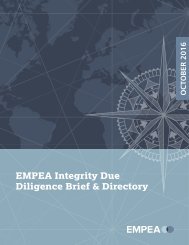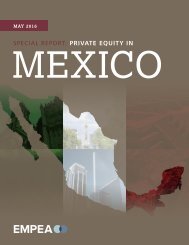You also want an ePaper? Increase the reach of your titles
YUMPU automatically turns print PDFs into web optimized ePapers that Google loves.
Z/Yen sees the core value-added themes <strong>of</strong> finance and financial centres as:<br />
THEME .................... SERVICE ..........................FOCUS<br />
Trust ......................Identities ..........................Community<br />
Space ...................Transactions .....................Payment Services<br />
Time .......................Debts .......................Investment Services<br />
Mutualisation ...................Pooling ..................Distribution and Concentration<br />
• Community —financial centres are both ‘open’ and ‘closed.’ Access to the community needs to be via confirmation <strong>of</strong><br />
identity and qualifications. At the same time, a too closed community cannot grow. A wider discussion might explore<br />
how diaspora <strong>of</strong>ten succeed internationally in growing networks, but with too restricted access to the community for<br />
outsiders they <strong>of</strong>ten fail to grow financial centres. A successful financial centre’s over-riding principle is ‘treating all<br />
comers fairly.’ This obviously underscores recent emphasis on the ‘rule <strong>of</strong> law’ as a key institution.<br />
• Payment services—are typically based around trade. Financial centres <strong>of</strong>ten grow from trade finance, and are thus<br />
<strong>of</strong>ten associated with ports or logistics interconnections.<br />
• Investment services—with the increasing recognition that a financial centre can be significant without a large domestic<br />
economy, think Zurich, Geneva, Singapore, or Hong Kong before the 1997 transfer <strong>of</strong> sovereignty, it is more evident<br />
that financial centres facilitate multi-party investments, most <strong>of</strong>ten cross-border.<br />
• Distribution and concentration—sophisticated financial centres <strong>of</strong>ten move into wholesale insurance and reinsurance,<br />
allocating risk capital where needed and adjusting returns from capital to provide good prices.<br />
1.2 Financial Centre Pr<strong>of</strong>iles<br />
Successful financial centres can and do fulfil more than one role:<br />
• ‘Global’ financial centres that are truly global foci, where only a few can claim that role, such as London, New York,<br />
Hong Kong and Singapore;<br />
• ‘International’ financial centres such as Seoul or Shanghai or Frankfurt that conduct a significant volume <strong>of</strong> crossborder<br />
transactions;<br />
• ‘Niche’ financial centres that are worldwide leaders in one sector, such as Hamilton in reinsurance or Zurich<br />
and Edinburgh in fund management, as well as Toronto, Vancouver, Johannesburg and Sydney in mining and<br />
extractive industires;<br />
• ‘National’ financial centres, <strong>of</strong>ten within federal countries, that act as the main financial centre for financial services<br />
within one country, such as Toronto or Frankfurt;<br />
• ‘Regional’ financial centres that conduct a large proportion <strong>of</strong> regional business within one country, e.g., Boston<br />
or Vancouver.<br />
There is much more information about the Global Financial Centres Index (GFCI) and its classification system online, www.<br />
globalfinancialcentres.net, but the table below provides a good indicator <strong>of</strong> a division based on quantitative parameters the<br />
categorises centres by global-transnational-local, broad-shallow and specialised-diversified.<br />
The pr<strong>of</strong>iles assigned to each financial centre in the GFCI are based on mathematical clustering and correlation analysis.<br />
There are three determinants <strong>of</strong> a centre’s pr<strong>of</strong>ile—connectivity, diversity, and specialty:<br />
• Connectivity—or connectedness, is the extent to which a centre is well known around the world, and how much nonresident<br />
pr<strong>of</strong>essionals believe it is connected to other financial centres. Respondents to the GFCI online questionnaire<br />
are asked to assess only those centres with which they are personally familiar. A centre’s connectivity determines<br />
116 |





